Peter MALONE
Saturday, 18 September 2021 19:45
Bhowani Junction
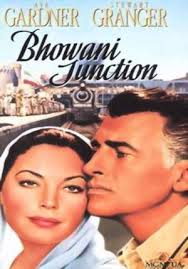
BHOWANI JUNCTION
US, 1956, 111 minutes, Colour.
Stewart Granger, Ava Gardner, Bill Travers, Abraham Sofaer, Francis Matthews, Freda Jackson, Lionel Jeffries, Marne Maitland.
Directed by George Cukor.
Bhowani Junction is a romantic drama set in India at the time of the British withdrawal after World War II. It touches on the major political issues of the time - the Congress Party, Ghandi's non-violent campaign, the communist agitators, the place of the Anglo- Indians and the feelings of the British themselves. The story is fairly run-of-the-mill, but in setting and with the location photography and some spectacle, the film is of more than passing interest.
1. Were you impressed by the atmosphere of authenticity about this film - the mass of Indian people, the Pakistan scenery?
2. How effective dramatically was the flashback technique? The audience thought that the beginning was a final parting, but only at the end was it seen to be a beginning.
3. Did the film help you to understand the political background of the British withdrawal from India and the variety of Indian attitudes to this withdrawal - relief, nationalism, the Congress Party and Ghandi's pacificism, the communists, the inciters to violence?
4. What was the place of the Anglo- Indians in this kind of society? Looked down on by the Indians as English, not accepted as fully English. What were their prospects after the withdrawal?
5. How were the railway and the junction used in the film as partly symbolic - communication, movement, connections as well as for disruption: demonstrations, stoppages, destruction?
6. Discuss the personalities of the principal characters. How were their personalities subordinated to their duties and the circumstances of the times?
7. How did Victoria see herself as an Anglo-Indian? How were her horizons widened during the war? Why did she differ in views from Patrick?
8. Why did Victoria, in her attempt to find her Indian identity, turn away from her friends and join the Sikhs? Why did she fail?
9. How did the violence and the murder of the sentry bring the awareness of violence closer to the audience?
10. Did those who favoured violence have any justification for the dynamiting of rails and trains and the murder of civilians?
11. Was the climax of the film with the train carrying Ghandi and the shooting in the tunnel effective or too melodramatic?
12. What did the film offer on racism, prejudice, fanaticism, peace, violence and non-violent protest?
Published in Movie Reviews
Published in
Movie Reviews
Tagged under
Saturday, 18 September 2021 19:45
Big Bad Mama
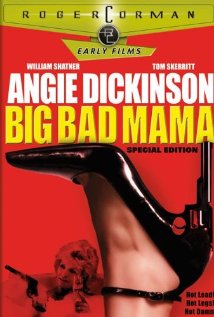
BIG BAD MAMA
US, 1974, 85 minutes, Colour.
Angie Dickinson, William Shatner, Tom Skerritt.
Directed by Steve Carver.
There must be a large collection of films about 30s gangsters of U.S. city and country. Here is another, directed by Steve Carver (Capone) and produced by the man responsible for so many of them as producer or director, Roger Corman. This one is the same material, a bit more explicit on sexuality but the same violence. And now we have Angie Dickinson, with two daughters, who takes to the road against society, dominating the two men she attracts for a series of hold-ups. She is a strange and wilful character. There is social comment on the injustice of the Depression, but the film is much the same as the others of its genre.
1. The Depression genre? The appeal of the 30s and interest in the 30s? The style of a gangster film?
2. The importance of the recreation of the scene: the homes, the countryside, cars, paradise Texas, the banks, the police, etc.? Did the environment explain the criminals?
3. The significance of Angie Dickinson as Mama? Audience response to the actress and the character she was playing? How much character was developed in Mama? A mother and her relationship to her daughters? The initial attitude towards marriage and her reaction at the wedding? Her reaction to Barney? Her self-assertion? Her antagonism towards the police? Her ambitions for money and to give things to her daughters? Do these explain her involvement in crime?
4. How did the screenplay make her gradual involvement credible? Her irascible personality and her erratic behaviour at the wedding, taking off her daughters and looking after them and protecting them, her reaction to Barney and the police chase and his being shot? The decision to take over his deliveries? The experience in delivering the Moonshine whisky? The people she met? The corrupt police? The police bashing?
5. How was it easy for her to become more deeply involved and to determine her life of robberies and raids? The visualizing of the robberies? The counterbalance of the human interest sequences, for example, the daughter at the striptease? Her encounter with the preacher and his phoney religion? Her getting the money from him? Her ability to rob banks?
6. The portrayal of the police? As persons? As upholding the law? AS determined and dedicated to catch the criminals? As obsessed? The nature of their pursuit?
7. The personalities of the two daughters? Their style? Relationship with their mother? Their involvement in crime? Their moral stances?
8. The social background of America in the 30s? The American Legion Dinner and the striptease?' The phoney preacher? The comment on a corrupt society which needed upheaval?
9. The bank robbery and the coincidence of the other robbery? The involvement with Diller? Diller's personality? His being subjugated by Wilma? The sexual involvement, his relationship with the daughters, his becoming a partner, his jealousy? The pregnancy of the daughter?
10. The contrast with Baxter? As a character, as a con-man, his performance at the races,, the entanglement with Wilma,, the infatuation, sexuality? The reasons for him joining them? His place in the group?
11. The film's treatment of the sexual relationships? Appropriate for this kind of film? The complication and realism of the pregnancy?
12. Wilma's growing ambitions and her determination to rob the people at the Ball? Her style in doing this? The social comment? The talk of the people and the contrast with Wilma's background?
13. The kidnapping of Jane and its accomplishment, Jane's imprisonment, her relationship with Diller and Baxter? Her quick thinking in trying to escape? Audience sympathy for Jane in her imprisonment?
14. Baxter's fear and Jane overcoming him?
15. Audience response to the shoot-out and the deaths? The usual culmination of American criminal careers? The violence inherent in the American tradition? The ugliness of such death and justice?
16. The presentation of persons, moral stances, the nature of crime and their attitudes towards crime?
17. The film's exploration of relationships amongst depressed people and criminals?
18. The Depression atmosphere and the understanding of the Depression? Class questions in social conscious America?
19. Frank Diller's final stand-out and being shot? The quietness in contrast with Wilma's death? What is the value of exploring these characters and their times? The relationship to social situations now?
Published in Movie Reviews
Published in
Movie Reviews
Tagged under
Saturday, 18 September 2021 19:45
Big Bounce, The / 1969
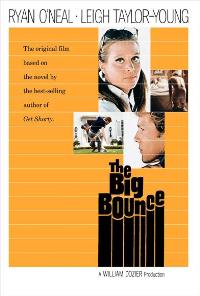
THE BIG BOUNCE
US, 1969, 102 minutes, Colour.
Ryan O'Neal, Leigh Taylor Young, Van Heflin, Lee Grant, James Daly, Robert Webber.
Alex March.
The Big Bounce was Ryan O'Neal's first feature film. He and his then wife Leigh Taylor- Young were working in television's Peyton Place. They make an offbeat couple in this somewhat unpleasant glamorous film. It begins with the atmosphere of Monterey and the social problems of the area - but soon moves into a portrait of a dropout, a precocious nymphet who manipulates him for her own purposes. There is a reasonably good supporting cast led by Van Heflin. The treatment is glamorous in the '60s style. Music is by Mike Curb. The film did not have wide release when it first came out. Ryan O'Neal depended on his performance in Love Story for his success.
1. A plush vehicle for a new star? Sixties content and style? Dropouts? Glamour? The film in its time? Now? Dated - the '60s becoming 'historical'?
2. Lavish Warner Bros. production, colour, Panavision? Monterey locations? The Mike Curb score?
3. The social setting with racial issues, work, justice, violence, wealth, exploitation? The establishing of the setting, the raising of issues - and little done with them?
4. The initial focus on Jack and his violent clash with the baseball bat? His background, war service? The film becoming a romantic melodrama focussing on Jack? The '60s glamorous style hero, dropout? (Well groomed variety!) The conventional story of the wanderer manipulated by a woman, the involvement in crime, infatuation and love, vengeance and decisions? His resenting being used?
6. The importance of the affluent backgrounds? How effectively were they used? How real?
7. Ryan O'Neal's style as Jack? Type, being ousted from the area, his work, clashes with Rogers. friendship with Richie? The infatuation with Nancy? The sexual liaison? (60s glamour, costumes, nudity etc.?) His work and the friendship with Sam? His relationship with the woman in Cabin 12? The hit-run episode? His discovery of the truth about Nancy? Thwarting her? His rejecting her at the end? His sense of values, integrity, right and wrong?
8. Nancy and her glamour? Age? Richie's mistress? Her taunting of Rogers? Her use of her sexuality? Nudity? Her throwing herself at Jack? Jealousy? Her plan? The irresponsibility of the hit-run episode? Her trying to shoot Jack? The finale with her smashing the wealth? Her driving off after acquittal? Her trying to pick up Jack and his rejection of her? A credible villainess?
9. Richie and his wealth. Nancy as his mistress? Richie and his power, business? Rogers and his work. attitude towards Jack, fight with him, relationship with Nancy, lust?
10. Sam and his administration of justice? Pragmatic attitude towards keeping the peace? Awareness of difficulties amongst the races and with work in the area? His decision to help Jack? Lecturing him? Supporting him?
11. Lee Grant as 'the broad in Number 12'? Pathos of her character, picking up Jack, relationship with him, Cheryl calling the men ‘uncles’? Her talk with Jack? overhearing his talk with Nancy? The pathos of her killing herself? Cheryl's reaction? Jack's support?
12. A picture of the '60s? Changing of values? Wealth? Exploitation? Race clashes? Aimlessness of the younger generation?
Published in Movie Reviews
Published in
Movie Reviews
Tagged under
Saturday, 18 September 2021 19:45
Big Brawl, The
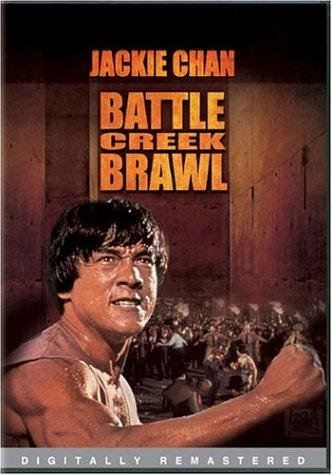
THE BIG BRAWL
US, 1980, 95 minutes, Colour.
Jackie Chan, Jose Ferrer, Kristine De Bell, Mako.
Directed by Robert Clouse.
The Big Brawl is a highly entertaining martial arts drama-comedy. The story and direction is by Robert Clouse, a director of thrillers like Darker Than Amber and The Amsterdam Kill as well as many martial arts films. His most significant was the Bruce Lee thriller Enter The Dragon. Clouse seems to be able to combine the tradition of the martial arts and the atmosphere of Asia with the American scene. This film is imaginatively set in the '30s, Chicago and the Mafia, the big brawl and wrestling in Battle Creek, Texas (for which, it seems, so many of the wrestlers of the United States were hired).
The film has a lot of conventional material, interestingly choreographed martial arts fights as well as a race on roller skates. The big brawl itself is an appropriate climax. However, the film is enhanced for a wide audience by a very tongue-in-cheek approach which makes a lot of the film hilarious. Jose Ferrer presides over a Mafia family. The outstanding member of the family is a rather crude-mouthed grandmother who has many excellent one-liners. The humorous tone and the audience response to the American setting in the '30s helps situate the martial arts fights and make quite enjoyable entertainment.
1. An entertaining film? The appeal of martial arts film? The eastern background, Chinese, Hong Kong? Martial arts staging, choreography, style? The American locations, setting, history? An enjoyable blend of east and west?
2. The adaptation of martial arts material to the 30s? The insertion into Chicago and its gangster background, the fights of the 30s? The build-up to the big brawl? San Francisco elements, the Texas elements? The flavour of American history of the 30s?
3. Colour photography, editing? Choreography, the quality of the martial arts material and audiences enjoying this? The roller skates competition? Jerry's training sequences? The big brawl itself? The violence, energy, competitiveness? The visual communication of the martial arts?
4. The title, its reference to the American historic event? The focus of the big brawl as competitive, dangerous for Jerry, important for the kidnapping, for the money-making of the gangsters, the climax of the film? Preparation, humour? The parody within the big brawl - of so many action film? The jokiness about the big brawl?
5. The American settings and audience presuppositions? Chicago and the slums, Chinese restaurants, Chinese families? The Chinese traditions and their being lived out in America? Marriage, business? The particular characters and their styles - father, uncle? The women? Loyalties? The conventional characters and their immediate impact? the use of cardboard characters for quick communication, for humour?
6. How engaging a hero was Jerry? His relationship with his father, his devotion to his uncle and being trained by him? Love for Nancy? Relationship with his brother? The fights - e.g. in the alleyway and the demolishing of the henchmen? The training sequences? Races? The attacks? The importance of the demonstration for Domenici? The elaborate training? The San Francisco sequences, the kidnap and the siege? The attack on Dominici's hone? The elaborate involvement in the big brawl? Jerry as hero?
7. The portrait of the family: father and his worries, the uncle and his training, the fat women? The brother, the girl from China and her being kidnapped, the substitute glamorous Chinese?
8. The portrait of the Mafia - Jose Ferrer as Dominici? The hoods, the incompetent nephew, the elaborate mansion? The grandmother and her violence, language, humorous attitudes? The demonstration for Dominici in the open air theatre, the plan for winning the big brawl, the rivals? The siege of the house, the kidnapping of the girl?
9. The incidental characters and their contribution - the young people at the roller skating competition, the San Francisco girl, the Battle Creek types?
10. The competitors in the big brawl - apparently the highlighting of American wrestlers? Their styles, theatricality? The Texas announcer?
11. The choreography of the brawl itself? The bell, the climax?
12. How enjoyable the blend of American story with Asian style? The self defensive win? A 'nice' martial arts comedy drama?
Published in Movie Reviews
Published in
Movie Reviews
Tagged under
Saturday, 18 September 2021 19:45
Big Bus, The
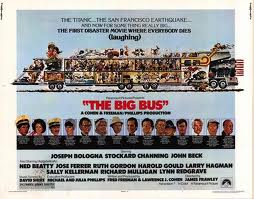
THE BIG BUS
US, 1976, 89 minutes, Colour.
Joseph Bologna, Stockard Channing, John Beck, Rene Auberjonois, Ned Beatty, Jose Ferrer, Ruth Gordon, Harold Gould, Larry Hagman, Sally Kellerman, Lynn Redgrave.
Directed by James Frawley.
The Big Bus shows how many audiences have found the disaster trend preposterous. This film has searched out the most preposterous highlights and relished compressing them into 89 minutes of fun. Airport, Airport 1975, Juggernaut have been particularly pillaged for bombs, collisions and little old ladies, but there are continued allusions to The Italian Job, Ship of Fools, 2001, even a misfired earthquake. The characters are skits on the motley types who have gone on recent cinema trips. The whole treatment is corny but makes no bones about it and, generally gets away with it, especially since the screenplay hurries us on to the next piece of impending doom. A good laugh.
1. Why was this film made? The tone of the title and its implications? The disaster trend of the 70s and its appeal? The necessity of a preposterous parody? The success of this film in fulfilling the need?
2. The build-up, the opening and the explanation and audience expectations? The pillaging of films like Airport, Airport 1975, Juggernaut, 2001? The use of the incidents, the characters, music and styles? How well did they combine? The gradual build-up and the propelling forward of the screenplay to each step of impending doom?
3. The quality of the humour? How clever, how corny, how broad? The ideas behind the film and its execution? The value of this kind of parody? Parodying the audience expectations for sensationalism? Comment on this as regards situations, characters, types? The language of the disaster trends and sensation?
4. The opening with the building and launching of the bus? The satire on the Press, the bus itself and its expectations, the atmosphere? The appropriateness of the use of Panavision and the music?
5. The launching of the bus and the people who managed it: the slapdash, the sentimentality, the injury of the maker with the St. Christopher medal and his not being moved, his decisions about the voyage? His daughter having to go? The manager and his sentimentality about Jack leaving when disaster was on the road etc.? What was this parodying?
6. The presentation of Dan in the bar brawl and the discussion about survival and cannibalism, the parody of a western brawl by the bus drivers as the new cowboys?
7. The cemetery sequence with Dan talking to the grave and all the people talking to the graves etc.?
8. The presentation of the bus itself, the visual impact, the Richard Strauss music launching?
9. Comment on the passengers and the parody of their types, the quality of the skits: the priest and his loss of faith, celibacy questions, rediscovery of faith and leading the people in Irving Berlin's songs: the old lady who looked like a stowaway and her vulgar language; the couple who were being divorced, their making love, their hate, the time of their divorce and their wanting to remarry? The fashion designer as a nymphomaniac on her arrival at the bus station, her snobbery, her decking out the people in her fashions; the vet who was asked to operate and was successful in using animal principles; the man who was dying in six months, the piano singer and his ironic lyrics about disasters?
10. Comment on the crew: Dan as a hero, the background of his cannibalism, his love life, his relationship with Kitty, his capacity for heroics, the heroics during the trip? The satire in Shoulder and his various blackouts and his comments on how he goofed? Kitty as the heroine: daughter of the maker, the designer, her relationship with Dan, her talking to the passengers, her drowning in soft drink and pretending in order to win Dan etc.? The hostesses as so glamorous? The managing crew back at the Centre and their squabbles about quitting, salary raises etc.?
11. The sensations with the bombs? The bomber and his various disguises? Iron Man and his masterminding of things? The earthquake and its misfiring?
12. The tension of dismantling the bomb and Dan's heroics? The fact that the bomb blew up?
13. The satire on the skidding of the foam through 'Springfield' and the landing in Airport?
14. The melodramatics of the bus hanging over the cliff, using the soft drink for ballast, Dan marrying the couple on his way to rescue Kitty, people freezing and using the fashion clothes, using the chandelier and the underwear in order to rescue the bus? Comment on the way that people's lives changed and finding love, religion, etc.? Their singing of the Irving Berlin song as a hymn?
15. The sudden ending and the impending disaster as the bus parted in two? The overall quality of the humour, the value of this kind of parody?
Published in Movie Reviews
Published in
Movie Reviews
Tagged under
Saturday, 18 September 2021 19:45
Big Chill, The
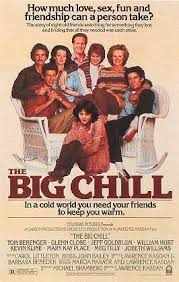
THE BIG CHILL
US, 1983, 100 minutes, Colour.
Kevin Kline, Glenn Close, William Hurt, Jeff Goldblum, Tom Berenger, Meg Tilley, Jo Beth Williams, Mary Kay Place, Don Galloway.
Directed by Lawrence Kasdan.
The Big Chill has become a cult movie. At its time of release, critics made comparisons with John Sayles' The Return of the Secaucus Seven, a film about middle-aged men and women having a reunion, talking about their past, re-examining their relationships, discussing the values of life. This is what happens in the reunion in The Big Chill.
The film is also a cult movie because of the range of songs from the 60s and 70s that were incorporated into the soundtrack. In retrospect, it also sees the emergence of several top actors at the beginning of their careers, especially Kevin Kline, William Hurt, Glenn Close. The former two were to win Oscars during the 80s and Glenn Close was to be nominated many times. The story about The Big Chill which people remember is that Kevin Costner played the dead body of the friend whom the others gather to commemorate. However, he finished up on the cutting-room floor. However, he was to film with director Lawrence Kasdan in Silverado and later in Wyatt Earp.
Kasdan had been a successful writer (Raiders of the Lost Ark) and began directing with The Big Heat. He made a number of successful films including Grand Canyon. After the failure at the box-office of the very solemn Wyatt Earp, he was quiet for several years, although he made the excellent Mumford, unfortunately not seen by many people. He emerged in 2003 with his adaptation of the Stephen King story, Dream Catcher.
1. The popularity of the film? Oscar nominations? Critical acclaim? Impact for American audiences? Non-Americans?
2. The work of Lawrence Kasdan - fantasy with Raiders of the Lost Ark and Star Wars films? His use of American genres in Body Heat, Continental Divide? His consciousness of American types, situations? Ironies?
3. The Carolina locations, the mansion, lifestyle? A piece of '80s Americana? The significance of the score - the selection of records, artists? Memories of the '60s? The significance of the lyrics and the characterisation and episodes?
4. The reunion genre: the basic situation, arrivals, initial encounters, emotional reactions, surface reactions, the move to deeper interaction, hurts, joys? An effective reunion?
5. The style of the film as less discursive than exploratory? The presentation of facets of characters? Contrived situations in which characters reacted?
6. The atmosphere of the film and its opening: talk, the baby in the bath, the news of the death and the tears, the collage of people dressing and the news of the suicide? Audience anticipation?
7. The transition to the funeral: the guests arriving, the role of each of the friends at the funeral and in the ceremony, the ceremony itself, the eulogy by the minister - and the anticipation of what he was going to say? The carrying of the coffin, the graveside? The party and the lightening of atmosphere? The jokes -and the comment on the poor taste of the jokes? The significance of the adolescent-style death jokes throughout the film?
8. The interaction at the party, the staying for the weekend, the collage of people's behaviour, the use of dissolves, the editing and the various glimpses of characters, entering in mid-conversation and leaving? The effect of audience getting to know and understand the characters? Character development in a brief time? The music and the lyrics relating to the characters?
9. The importance of memories: college days, the dead friend, the time at college when they were themselves, youthfulness, dreams, vision, an earnest hope for the future? The short time that they were together and had bonds with one another? Strengths, weaknesses? Memories of lost opportunities? The shallowness of their subsequent lives? Having to face the transition from college to mid-lives?
10. The portrait of each of the individuals:
a) Harold and Sarah - their marriage, their child and their love for the child, the story of the infidelity told by Harold, by Sarah? Their business, organisation, responsibilities? The church, the wake? Sarah and the significant scene of her grieving, nude? Harold and his talk? Business, the visit to the block of land, success? Jogging, business tips? The warmth of Harold and Sarah together? Sarah and her strength, her good sense, empathy? The significance of Meg and her wanting a child? The credibility of Sarah's arranging for Harold to father the child? Its significance, effect on the friendship, on the marriage?
b) Meg - her grief, alone at the back of the church, her being stoned? Her isolated life, being alone, her capacity for loving? Her career and the law? Her moving from needy cases to more professional cases? Her relation to each of the group? Her wanting the baby, flirting? The consummation of the relation ship with Harold?
c) Karen and Richard - the marriage, its effect, Karen playing the organ, her grief? Richard as a fussy husband, his comments the night sandwich, his going? Karen and her memories? Her seeming to have succeeded? Her family, children? The other men in love with her from the past? Sam and the sexual fascination?
d) Sam and his glamour, Karen and his dreams, the autographs of the celebrity, the TV role: J. T. Lacey - the group watching his performance, the mocking of television series with the macho image, the violence? The failing for the police, sympathy, Karen and sexual relationship?
e) Michael and his appearance, working for 'People Magazine', brashness, flirtatious, talking, ringing up hot news, pursuing everybody? When alone? His comic style - and the clashing with Sam?
f) Nick and his arriving late, appearance, his being stoned, the Vietnam experience, his isolation, drug-pushing? His attachment to Chloe? Reaction to the others, the car-ride, his bitterness, truth, Michael's article?
g) Chloe - young, callow, literal in her interpretation of what people said, laughter, few memories, easily able to comfort her self after Alex's death, joining in the group, excluded from it? Nick becoming a new Alex for her?
11. Alex as focal point - yet never seen, partly known, partly unknown? His being constructed by the images of each of the eight? The attitude of each of the eight towards him? Genuineness of their grief? His bringing them together in death?
12. The exploration of friendship and its qualities, love, companionship, truth?
13. Themes of truth, selfishness? The expose aspects of the film? The ultimate gentleness of the ending?
14. The importance of these people, their seeming self-satisfaction and smugness, the significance of the reunion on their lives? Thews of consequence, inconsequential matters? The inconclusive ending - their future? A comment on the young Americans of the '60s?
Published in Movie Reviews
Published in
Movie Reviews
Tagged under
Saturday, 18 September 2021 19:45
Big City / 1937
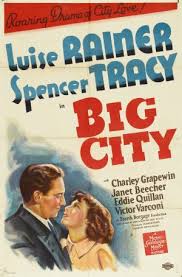
BIG CITY
US, 1937, 80 minutes, Black and white.
Spencer Tracy, Luise Rainer, Charley Grapewin, Janet Beecher. Irving Bacon. William Demarest, Eddie Quillan.
Directed by Frank Borzage.
Big City, or The Skyscraper Wilderness, is a very minor Spencer Tracy vehicle. It was made at the time he was winning Oscars for Captains Courageous and Boys' Town and making popular film like Test Pilot and San Francisco. He co-stars with Luise Rainer who had won Oscars for The Great Ziegfeld and The Good Earth.
Direction is by Frank Borzage who made some moving, if sentimental, comedies and dramas. This is a story about small people confronting organisation and crime in the big city. The film is brief, pleasant if at times raucous and significant only because of the stars at the height of their success. There are cameo appearances by famous boxers of the time, including Jack Dempsey, James J. Jeffries, Jim Thorpe, Man Mountain Dean and Maxie Rosenbloom. They join Spencer Tracy and the cab drivers in a punch-up with the hoodlums in the finale of the film. Minor entertainment.
1. A star vehicle for Spencer Tracy and Luise Rainer? Suitable for their talents? An entertaining piece of minor Americana?
2. Brevity of the running time? Studio photography? The atmosphere of the big city - especially as seen from the point of view of migrants, taxi drivers etc.? The syndicate-type organisations and their hoodlums?
3. The old story of the little people versus the organisation? Violence. their being put upon, their rousing themselves and winning? How well illustrated was this theme?
4. Spencer Tracy as a taxi driver? An independent? Seeing him at work, his relationship with his wife., family, the apartment? Friends? The attacks on the independent cab drivers and the violence,, the destruction? His decision to go along with organisation? The exhortation to stand against them?
5. Luise Rainer as the housewife? Migrant background.. love, tenderness, support?
6. The range of relations,, family interactions? The interdependent cab drivers and their supporting one another, feeling the pressures of organisation?
7. The big city and organisation, takeovers, money-making, the use of hoodlums for violence?
8. The taxi drivers' friends and the boxers? Their coming to the aid of the hero and the spectacular punch-up at the end?
9. The popular American theme of the little man versus organisations? 'Thirties style?
Published in Movie Reviews
Published in
Movie Reviews
Tagged under
Saturday, 18 September 2021 19:45
Big Combo, The
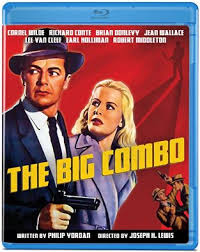
THE BIG COMBO
US, 1955, 80 minutes, Black and white.
Cornel Wilde, Richard Conte, Jean Wallace, Brian Donleavy, Robert Middleton, Lee Van Cleef, Ted de Corsia, Helen Walker, John Hoyt.
Directed by Joseph B. Lewis.
The Big Combo is a short grim thriller, anticipating the Mafia and police thrillers of the '70s. It was written by Philip Yordan who gets title credit. A prolific screenwriter, his range included Detective Story and House of Strangers as well as the spectacles Fifty-five Days at Peking, El Cid and The Fall of the Roman Empire. At this time he also wrote Johnny Guitar, a bizarre western with Joan Crawford. While interested in the basic plots and conventions, he is interested in unusual characters and bizarre relationships of power, love-hate, sexuality and cruelty.
This is evident in this film which is a routine thriller of syndicates and police but also shows the strange relationships between detective and hoodlum and the woman at the centre. There is also a direct picture of homosexual gunmen working for the chief hoodlum. The cast is very interesting and includes husband and wife team Cornel Wilde and Jean Wallace, with Richard Conte and Brian Donleavy as expert villains and Lee Van Cleef and Earl Holliman in very early roles as the murderous gunmen. Music is by Dave Raksin, composer for such films as Laura and direction is by Joseph H. Lewis, who directed second features which have considerable reputation as My Name is Julia Ross and Gun Crazy.
1. An interesting gangster film? The gangster tradition in the American cinema - the grim direct films of the '30s, the police stories of the '40s and '50s? The basic conventions of plot, clash with police and gangsters, the personalities of the criminals, their women? In comparison with the styles of the '70s? The quality of this 'B' feature?
2. The black and white photography, the sleazy atmosphere, the violence in the photography and editing? A world of corruption, sadism? The contribution of the score? An anticipation of the trends of the '60s and '70s?
3. The strength of the cast, character actors and actresses and their ability to represent types quickly and directly? The strength of the performances?
4. The screenplay and its taking of a basic conventional plot and enhancing it by a study of relationships? The blend of the ordinary and unusual? The relationships and attitudes of power, love and hate, sexuality, cruelty?
5. The focus of the title and the emphasis on American syndicates, protection and corruption, the bosses, the henchmen and the gunmen? The amoral atmosphere of this world? The police and their abilities and inabilities to combat it?
6. The initial focus on Susan and her trying to escape at the start, the ambiguity of the well-educated glamorous girl with Mr Brown? Her dancing, suicide attempt? The interrogation in the hospital and the clue of Alicia? Her return and clash with Brown - as symbolised by her listening to the classical music? Her decision to leave, her reliance on Leonard, her decision to help? Her pleading with Alicia? Her being kidnapped at the end, her focusing the spotlight on Brown? Walking off with Leonard? How well did she show how people could be attracted by gangsters and criminals and repelled? The balance of her being attracted to Brown and Leonard? How well did she illustrate the ambiguities of her character, the ambiguous attitudes of people towards criminals and the law?
7. Cornel Wilde as hero - Leonard and his skill as a policeman, the funds he used for his long investigation of Brown? The discussions with Peterson and his support from him? His assistant and the information given, his finally being shot? The desperate interrogation of Susan at the hospital? His visits to Rita and reliance on her - sexual liaison, the suggestiveness of her work at the burlesque, her availability? His reaction and tears at her death? His relentless pursuit of Brown? The importance of the picking up of so many criminals, the lie detector sequence? His motive for pursuing Brown and Peterson's comments on his being in love with Susan? The balance of his being tortured by Brown - especially with the hearing aid? The alcohol? His tracking down Alicia and his visit to the former syndicate man who was afraid that he was going to be killed, the discovery of Alicia and talking to her in the asylum, his violent confrontation of the truth? Interrogation of her and using Susan to break her down? Her finally helping him though she said she didn't want to? Why was Alicia unpersuaded by Leonard?
8. His motives of vengeance especially after Rita's death? His tension, violent outbursts? His control at the end and not using violence on Brown but taking him to prison?
9. Brown and his control - his being called Mr. Brown and its irony and oddity? His theory about hatred and explanation to the boxer? His explanation of overcoming McClure? and making him his henchman? The truth about his murder of Grazzi? His wife's becoming an alcoholic and his putting her in an asylum? His capacity for murder and then pleasant meals, torture - of Leonard using the hearing aid? His reliance on Fanti and Mingo? His dominance of them and their loyalty? His reaction to being picked up and interrogated with the lie detector? His ability to phone in the middle of the night and order killings? His presence being enough to make Alicia afraid? The suave letting Mingo and Fanti open the bomb? His escape plan, his taking Susan. his cowardliness and cowering when caught and put in the spotlight? The film's analysis of the tough hood who rises to power on hate but is able to be broken? The callousness of his killing of McClure?
10. The picture of McClure? - a former boss. weak and overcome by Brown, his hearing aid and its use in the torture after he had tortured Leonard? His reading of the situation and getting Mingo and Fanti to kill Brown, their turning on him, the macabre aspect of his being killed without the hearing aid?
11. Fanti and Mingo - killers, lack of scruple, their treatment of Susan, their torturing people? Their relationship and its homosexual overtones? Their attitude towards McClure? and killing him? The irony of the hideout and their trusting of Brown and his killing them? Mingo’s final talking?
12. A picture of the police and their power and powerlessness to control such organised crime?
13. The American gangster tradition, a picture of American corruption, conscience, good and evil, its attraction and repulsion?
Published in Movie Reviews
Published in
Movie Reviews
Tagged under
Saturday, 18 September 2021 19:45
Big Country, The
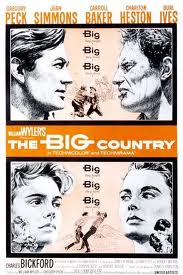
THE BIG COUNTRY
US, 1958, 166 minutes, Colour.
Gregory Peck, Charlton Heston, Jean Simmons, Carroll Baker, Burl Ives, Chuck Connors, Charles Bickford.
Directed by William Wyler.
The Big Country is certainly a big Western and recommended to anyone who wants to enjoy and study Westerns, The story is broad in scope, the stars very good, scenery, music very striking. Burl Ives won an Oscar for his performance. Veteran director William Wyler made this film just before Ben Hur.
1. Was this an enjoyable Western? Why? Comment on its scope, its history of origins, sense of history, pioneering in frontier atmosphere? Its picture of the nineteenth century, the United States and traditions, the interpretation of history? Did the film live up to its scope?
2. Comment on the technical side of the film - wide screen, colour, the vastness of themes, atmosphere, music, especially the theme. The Big Country in title and its presentation as grand? The belief of the people in the Big Country and the effect on them of owning the Big Country?
3. How did the film focus attention on James Mc Kay? Audience sympathy for him? The stranger coming from the East. the Eastern gentleman contrasting with the West, especially the early raucous sequences? The values that Jim McKay? stood for love, respect. non-violence? His sincerity and love for truth? His gallantry? His sense of vision in the experience of the Big Country? The film showing him as a good foundation for America? The fact that Gregory Peck played this role and brought his style to it?
4. How interestingly did the film portray the Terrels? Their arrogance, sense of pride, their fight, the major and his ambitions and pig-headedness, his provocation to his enemies, his attitudes towards his daughter, her sharing in these? Lynch's loyalty to these ideals, the sense of hostility to the Hannesseys, especially in the dinner sequence and the confrontation? The irony of the duel in showing the futility of such enmities? How were the Terrels presented as typical of the foundation pioneers of the Big Country and what comment was made on them?
5. How typical a Terrel was Patricia? The way she behaved in the East compared with at home in the West? Her arrogance, her love for Jim, her love for the country, her attitude towards Julie? Her sense of pride in Jim and wanting him to be strong and just like the others? Her wanting to own the land? Her selfishness and her deceptions? What judgments did the audience make on her?
6. How interesting a character was Steve Leach? His own background, his sharing in the Terrel arrogance? His dependence on the major, his humiliation of Jim McKay?, the love motivation and his attitude towards Patricia? The scenes of his harshness to the Hannesseys and the confrontations? why did he rebel against the major? Why did he go back on his loyalty? What values did he represent? His value as a pioneer of the frontier?
7. How attractive a character was Julie? A contrast to Patricia? As poor, as a teacher, rich as an owner, the sequence with the house and her talks with Jim? Her goodness to Pat and to Jim? Her relationship with Buck Hannessey? Her relationship with Rufus and his wanting to get the land from her? As victimized by being captured? Her power in having the deed-of-sale? The fight over her and the effect it had on her? The future and Julie as a pioneer?
8. How sympathetically were the Hannesseys portrayed? Was the film fair to them? Their poverty, victimisation, the vindictive nature of their actions, the need for water and the results on their attitudes? The sons as ne'er-do-wells and persecuting Jim? Buck as a coward compared with the others? Their behaviour towards children? The confrontation at the homestead, the hassling of Jim? The feud and Buck's fear of death? The drama his cowardice and being shot by his father? Was this convincingly dramatic and what insight into the family relationships did it give?
9. How much audience sympathy was there for Rufus? How good was he, how bad? The sequence of his defiance of the major? His treatment by the major? Yet he was as greedy as the major. His attitudes of justice towards Julie? To Jim? To Buck? The foolishness and significance of the canyon duel? Was he any different really from the major in character?
10. What comments on hostility and fighting did the film give? Especially in the final duel?
11. What Western conventions did the film use? How well? what values did it explore well?
Published in Movie Reviews
Published in
Movie Reviews
Tagged under
Saturday, 18 September 2021 19:45
Big Cube, The
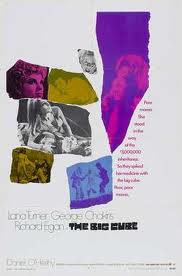
THE BIG CUBE
US, 1969, 98 minutes, Colour.
Lana Turner, George Chakiris, Richard Egan, Dan O'Herlihy.
Directed by Tito Davison.
The Big Cube is a cinema oddity. It is difficult to sit through - and, indeed, is quite risible at times.
However, the intentions of the film were good. Director Tito Davison worked with Luis Bunuel. The film was shot in Mexico. A group of American stars perform - but are defeated by the lurid heightened melodramatics of the plot. Lana Turner is an ageing actress. We see her performing on stage (not too persuasively), marrying Dan O'Herlihy and inheriting his daughter. She becomes the victim of the daughter's jealousy, goaded by her gigolo boyfriend (George Chakiris). Richard Egan is in the wings to support Lana. The film echoes the psychedelic trendiness of the late '60s in its colour photography. There is also a focus on drug-taking with its hallucinogenic effects. The film becomes a kind of Gaslight towards the end with the couple trying to drive Lana mad. While there is a forcefulness about the film, it is an example of '60s trendy film-making and absurd melodrama.
Published in Movie Reviews
Published in
Movie Reviews
Tagged under